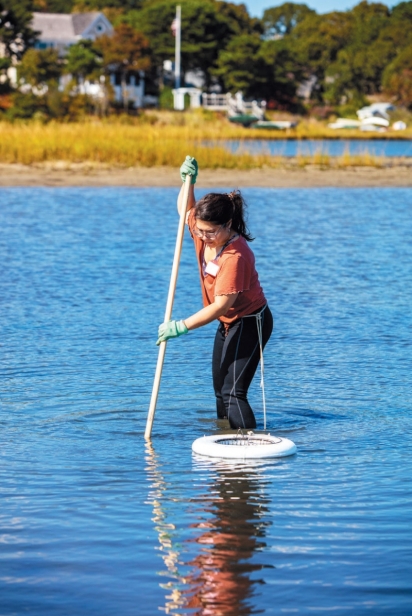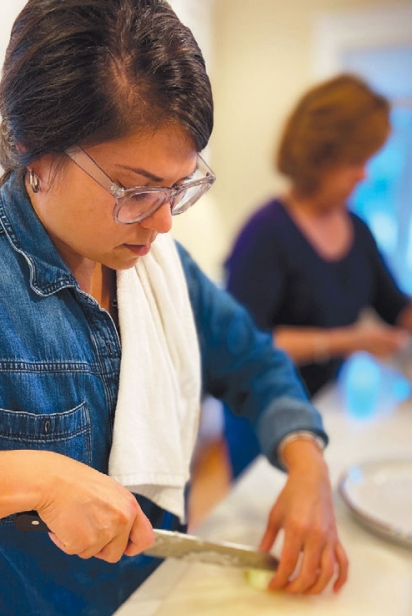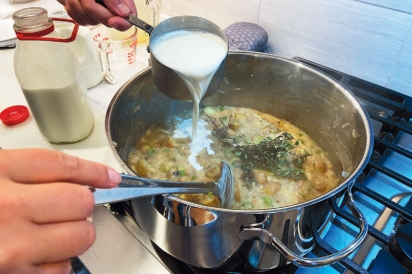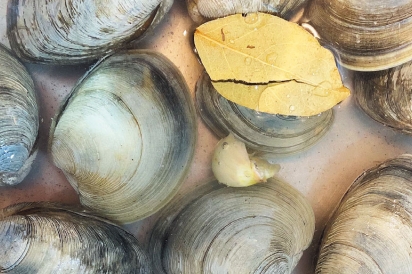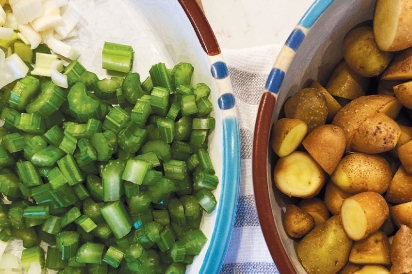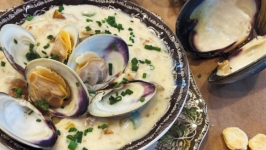Clam Chowder in the Time of COVID
This past year, I’ve sometimes wished I was a clam, closed in upon myself and buried deep in muck. There is too much going on, and too much with which to grapple. I wish to remain blissfully unaware of it all.
But it’s also dark down in the sand, and lonely. I would be irresponsible to willfully disregard the circumstances of the world, no matter how confusing and hard they may be. Also, I would be ignorant of the wonders around me. I couldn’t do things like feel the crush of slipper shells under my boots, sit on my favorite bench watching the tiny houses bob in Woods Hole Harbor, or meander through the trees of Bourne Farm.
Where does one start when trying to tackle the events and issues of the past year? I hardly know how to convey my thoughts in any fashion, let alone write about them responsibly and respectfully.
So instead, I’m here to write about clam chowder. Or rather the earth and sea and the products of both that comprise the ingredients list of this historic soup. For me, there isn’t a food more symbolic of comfort, good memories, family and Cape Cod.
This is my tribute to the good of 2020, and my attempt to encapsulate everything I’ve been feeling and learning the past several months: the gifts of nature, the friendship within my family, and the pursuit of truth and wonder.
The Idea
I love the Cape, but my gratefulness for this special place exponentially increased when I was more or less confined to it earlier this year when I stayed with my parents. While the scope of my personal vicinity decreased, my observation and wonder grew, and the places I’ve always found lovely became lovelier than ever before.
The Cape has so much to offer beyond its stunning scenery, though, a realization emphasized for me by the uncertainty of, well, everything in the early spring, and the sudden vulnerability of doing simple tasks, like going grocery shopping. I began to wonder what was accessible locally, without having to depend on a supply chain or national grocery store. So, the idea came about to make a recipe with only local ingredients, in particular clam chowder, as it includes produce, dairy, and proteins from both the land and the ocean. Plus, I happen to love eating it.
Before proceeding, I would like to share the following disclaimer: I am not a chef, a hardcore outdoors person, a longshoreman, a fishing afficionado, or a marine biologist. But I think that’s what really motivates me to share this story — we are all trying to make our way, and there is a whole world out there for us to partake in. We do not need to be experts, and we certainly do not ever need to feel intimidated to try something new or seek new knowledge.
The Guidelines
I gave myself a few parameters when on the hunt for ingredients. If possible, I wanted the item to be from Cape Cod, but I’d also settle for a Massachusetts-sourced ingredient if needed. If neither of those was an option, I was fine with the 100-mile “rule” that’s largely accepted as a qualifier for local ingredients, although a verified source for this information was elusive. The USDA cites the 2008 Farm Bill for their definition of local as within 400 miles, or same-state production. I found the 100-mile rule to be more casually accepted and based upon a book titled The 100- Mile Diet: A Year of Local Eating, by Alisa Smith and James MacKinnon. I touched base with Susan Sigel Goldsmith, the owner of the Bootstrap Farm Club, who uses the 100-mile guideline for her shop, and she confirmed it was more of a general rule versus from a specific source.
A final note: both the Cape and the Commonwealth would require extensive travel time to traverse. Thus, I did not travel more than an hour’s drive from my parents’ to keep this project more manageable and realistic.
The Recipe
This clam chowder recipe is brought to us by Chef Andrej Klimovsky, a private chef and owner of Cape Cod Private Dinners. Chowder recipes have been around for hundreds of years, and, while the New England version has a variety of iterations, it’s largely the same at its core. However, Chef Andrej credits the inclusion of leeks and use of high-quality bacon to really set his recipe apart. Not to jump ahead here to “The Eating” section, but I agree.
He told me this is the first time he’s written the recipe down, and I’m so grateful for the opportunity to use his creation to highlight high-quality local ingredients. I couldn’t have imagined a better stage for the produce, bacon, dairy and clams to shine.
The Process
To pinpoint sources for ingredients, I started with none other than trusty Google, but even algorithms have their limits. While certainly not exhaustive, the search results were a good start. I tried using both generic terms related to local produce, as well as searching for specific ingredients.
Curious about local dairy on the Cape and not finding anything definitive online, I emailed Jennifer Dwyer of the North Falmouth Cheese Shop (Stop everything you’re doing, even reading this piece, and go there!) to inquire if she knew of any local dairy on the Cape. She pointed me to the website Buy Fresh, Buy Local Cape Cod (buyfreshbuylocalcapecod.org). This ended up being my predominant source of information, besides the places I already knew about, such as the Bootstrap Farm Club, Falmouth Farmers’ Market and Coonamessett Farm.
While gallivanting about, I bought ingredients as I saw them just in case I wouldn’t be able to find them later. Thus, I ended up with doubles of multiple ingredients, including potatoes, onions and bacon. (Don’t worry — I used all of these ingredients in other recipes, including potato leek soup, bacon chive scones and onion jam.) While I did spend more than necessary, I was happy to buy from these farms and businesses, and, as a demonstration of support, I’m including their information along with the sources of the ingredients I ended up using.
The Clamming
Herein lies my dignity, because we are about to take a comedic turn (I even donned wetsuit pants for this story). Wanting to remain as true to this experience as possible, I decided I’d dig my own clams. I’ve been clamming before but only casually, and never with a quantity goal. I’ve also only ever been to Bournes Pond in Falmouth. An idyllic place to be sure, but perhaps not the best choice for clamming when I needed a large amount.
In theory, clamming is not very difficult and, as an experience, offers an authentic, literal get-your-hands-dirty taste of Cape Cod life. You take a rake and a floating peck bucket and sift through the sand, hoping against hope to feel the scrape of metal against a clam shell. I like to dig with my (gloved) hands to feel the clams with my fingers. Anyway, what is actually more difficult is the geographic expertise, the “I know a spot” assuredness akin to fishing.
In fact, while I was clamming, I overheard a conversation between two other folks out in the pond near me. One had mentioned it was his first time clamming and that he’d asked in a Falmouth Facebook group if anyone knew any good clamming spots but received little to no response. The guy to whom he was speaking chuckled and said that people would rather give away their bank account information than their favorite clamming spots.
I confess, after a few hours of digging, I had... wait for it... 21 clams. You can laugh. With a blister forming in the nook of my thumb and index finger, and with my arm muscles already screaming in protest, I knew I had to call it a day.
But, no need to panic. I contacted The Clam Man, a local Falmouth fish shop, who had chowder clams from Waquoit Bay in stock and ready for me to swing by and pick them up. Done and done. I still think clamming is fun though, but if wading in muck isn’t your thing, I highly recommend sourcing from a local seafood shop.
For reference, my measly 21 clams fetched from Bournes Pond weighed 2 lbs. 8 oz. with shells, which rendered about 2 oz. of meat. Sad, I know. The quahogs from The Clam Man were about 7 lb. (a total of 15 clams), which rendered about 9 oz. of meat. Chef Andrej’s recipe calls for a pound of meat, but he confirmed that 12 to 16 oz. would suffice.
After my experience, I spoke with evan Eastman and Jim Young of Eastman’s Sport & Tackle in Falmouth about beginner clamming tips. (I fully own that I should’ve spoken with them before going, but I think I was a little too big for my britches/ wetsuit pants.) They both stressed this very important takeaway: every town has different requirements for shell fishing, down to the type of equipment you use. Before traipsing out into the muck, make sure you have the right permit, the proper tools, and at least a basic understanding of the tide schedule (low tide is easiest).
Additionally, towns like Falmouth rotate which areas are open and closed, helping to control the availability of the clams. Young recommended going when certain areas first open, that way they’re not “annihilated,” as he referred to my spot of choice: Bournes Pond, which would explain a lot.
Young clarified with me that he likes to refer to clamming as quahogging to emphasize the specific species. Little necks, cherrystones and chowder clams are all technically quahogs, whose shells often feature the pretty purple edges that were traditionally used as wampum, and now in Wampanoag jewelry.
You might want to wait for warmer weather, but Young did say plenty of people go in the winter as well. He recommends long waterproof gloves and waders to protect your arms and legs against the cold water.
The Ingredients
Milk and Butter: Hornstra Farms, Norwell, MA. They were out of heavy cream when I purchased the milk and butter. They said that all of their heavy cream is reserved for ice cream production when it’s in full swing, which I support 100%.
Heavy Cream: Wright’s Dairy Farm, North Smithfield, RI, via the Bootstrap Farm Club in Cataumet, MA
Bacon: Lilac Hedge Farm, Holden, MA via the Falmouth Farmers’ Market. (Also purchased from Martinelli Farm & Charcuterie, North Scituate, RI, via the Bootstrap Farm Club in Cataumet, MA.)
Celery: Kitchen Garden Farm, Sunderland, MA via the Bootstrap Farm Club in Cataumet, MA
Onions: Cape Cod Organic Farm, Barnstable, MA. (Also purchased from Silverbrook Farms in Dartmouth, MA, via the Falmouth Farmers’ Market.)
Leeks: Allen Farms, Westport, MA via the Falmouth Farmers’ Market
Potatoes: Cape Cod Organic Farm, Barnstable, MA (Also purchased from Pariah Dog Farm in Falmouth, MA, and Allen Farms in Westport, MA, both via the Falmouth Farmers’ Market.)
Chives and Thyme: Coonamessett Farm, Falmouth, MA
Flour: Bob’s Red Mill All-Purpose Flour via Market Basket. Freedom Food Farm in Raynham, MA grows wheat and rye and has it milled locally. They were out of milled flour when I went, so I bought wheat berries to try experimenting with at a later time.
Clams/Clam Juice: Bournes Pond, Falmouth, MA, via my hours of fruitless labor; and The Clam Man, Falmouth, MA
The Cooking
Let me get even more vulnerable: I recruited my mother for the cooking part. Her aplomb in the kitchen is so much more to me than the guarantee of a good meal. It’s a quiet service, a selfless conquering, a laying down of her time for her family. Granted, I’ve never cooked more in my entire life than these past few months, but this was a sacred recipe, and I was not about to risk failure.
All of that said, Chef Andrej’s recipe is accessible and easy to follow. His design lends flexibility to any chef ‘s particular background, experience (or lack thereof ), and proclivity in a kitchen. The only tips I would offer are to read the recipe in advance to understand the order of assembly, and to have everything chopped and the dairy poured ahead of time. I was glad to have my mother with me, if only for company’s sake, but I am confident that I could have tackled the recipe on my own.
If you do dig your own clams or purchase them from a local shop, you’ll want to take special care to clean them. An easy method is to submerge them in a bowl of water for an hour or so and add cornmeal, so they can “spit” out sediment. When steaming them, make sure to save enough broth for the clam juice.
The Eating
With a scoop of a chowder spoon, I had in one bite both the sea and the earth, borne out of the briny clams’ dance with every green and rooted thing, bound together by the thick cream and smoke of the bacon. Another bite — there were the soft, rich potatoes and the bright green celery, more concentrated in flavor than any grocery store celery I’ve ever had, and, just as Chef Andrej said, the leeks! Oh, the leeks with their distinctive, elevated allium taste and bearing the flavors of earth.
There was quiet between my parents and me as we ate, thoughtful, attentive, savoring every layered bite. While I love nothing more than talking with friends and family around a table of food, it is in the silent moments where the wonder occurs.
The Conclusion
I can’t conclude this piece without acknowledging the blessings and joy I experienced purchasing all of the items for the recipe (and then some), as well as eating the final product. The New York Times, The Atlantic, TIME and countless local media sources have reported on the surging demand at food banks nationwide, as they work to keep up with growing needs in their communities. As such, I redirected the fee for this piece to the Falmouth Service Center’s food bank.
It’s the holidays now, and while a lot remains uncertain, of this I am sure: the friendship and love of my family, the gifts of the sea and the land, and the rhythms of nature that ebb and flow here despite the chaos around us. Take heart, lend a hand, and lean into the wonder around you.



